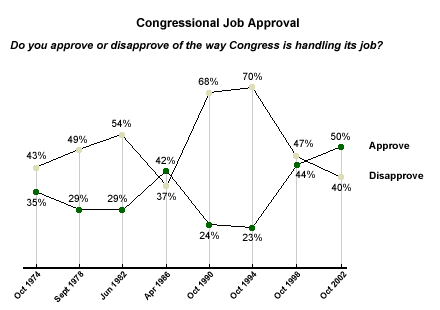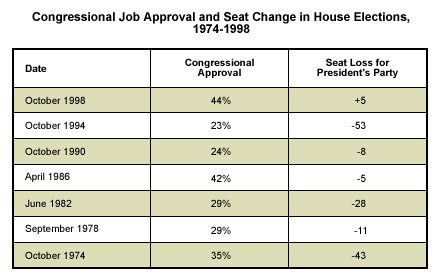In just three weeks, Americans will head to the polls to elect their congressional representatives for the next two years. A net switch of just six seats from the Republican Party to the Democratic Party would give Democrats control of the House for the first time since 1994. A net shift of just one seat in the Senate would give Republicans control of that chamber after losing it in May 2001 when Sen. Jim Jeffords, I-Vt., left the GOP. Heading into this critical midterm election, half of Americans say they approve of the job Congress is doing, which may bode well for incumbent members seeking re-election.
The current congressional approval rating* of 50% is the highest Gallup has measured leading up to a midterm election, and the first time since Gallup regularly began tracking congressional approval in 1974 that more Americans approve than disapprove of Congress as a midterm election approaches.

Public ratings of Congress bottomed out in the early 1990s. At that time, many states considered enacting term limits for members of Congress. (Such limits have never been put into effect for federal officials, but many states now have term limits for state legislators.) This anti-Congress sentiment may have contributed to the shift from a Democratic majority to a Republican majority in both the House and Senate in 1994.
Since that time, Americans have assessed the national legislature more positively, probably due in part to an improving economy in the late 1990s and increased trust in government since the Sept. 11 terrorist attacks. Since August 2000, more Americans have approved than disapproved of Congress each time Gallup has asked the question, and in only a few instances have less than a majority approved. This includes a record-high 84% approval rating in October 2001, shortly after the terrorist attacks.
The more positive evaluation of Congress may also be influenced by generational change. Gallup polling has consistently found that older Americans are more likely to disapprove of Congress than younger Americans are. Americans aged 65 and older are especially likely to be critical of Congress, while over the last several years, a majority of Americans in the 18- to 29-year-old age group have tended to approve of Congress. Thus, since 1994, as the U.S. adult population has seen older Americans (who tend to be critical of Congress) pass away and be replaced by younger Americans (who are more positive toward Congress), congressional ratings overall have become increasingly positive.
What Does This Mean for the Election?

However, the data appear to show that seat changes have tended to be minimized when congressional approval is higher. The 1986 and 1998 elections resulted in net changes of just five seats (a five-seat loss for the Republicans in 1986 and an unprecedented five-seat gain for the Democrats in 1998).
Key Points
A higher congressional approval rating may mean that there will be very little shift in the percentage of seats held by each party following this year's midterm elections. This notion is supported by a Sept. 20-22 Gallup Poll that found 57% of likely voters saying that most members of the House of Representatives deserved re-election, and 74% saying that their representative deserved re-election. Both numbers are high by historical standards. The question to be answered on Nov. 5 is if whatever shift occurs is enough to change partisan control of either house of Congress.
*Results are based on telephone interviews with 1,502 adults, aged 18 and older, conducted Oct. 3-6, 2002. For results based on the total sample, one can say with 95% confidence that the maximum margin of sampling error is ±3%.
